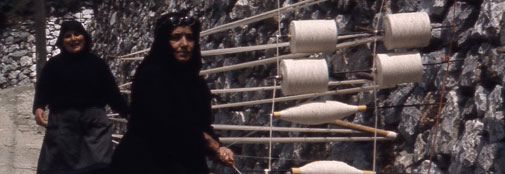Textile Economies in the Mediterranean Area
Previous CTR project

The TEMA research program is based on a collaboration between the CTR, international research centres such as the CNRS, and the National Museum of Denmark. The program is headed by CTR director Marie-Louise Nosch and is hosted by the SAXO Institute, University of Copenhagen. TEMA research is conducted in collaboration with a large group of scholars from European and North American research institutions (see list of collaborators).
The research program is firmly based on the research results obtained at the CTR from 2005-2010 on both textile tools, textile technology and textile terminology, but now takes textile research into a new domain: the placement of textile production within economy and within society in the 2nd and 1st millennium BC. The program investigates Mediterranean textile cultures in the Bronze Age to the end of the Roman period with particular focus on the production and management of textile resources in agriculture and trade, and the interaction between environment and textile production.
Further research topics include
- an international team of scholars surveys the economy of wool, both in the Bronze Age palace cultures and in the later Graeco-Roman world;
-
the terminology of textiles in Greek and the classification of the textile vocabulary;
-
the role of domestic vs. non-domestic textile production in 2nd and 1st millennium. Greece, especially the economic and cultural history of textile production in non-domestic contexts;
-
archaeological textiles and textile tools are explored at Khirbet al-Mudayana, in collaboration with the Jordanian-Austrian-Canadian team.
-
the development of flax into a resource for both food (seeds) and textile production (fibres) and the impact of this development and its demands on agriculture and agrarian praxis;
-
finally the important issue of textile production in sanctuaries will also receive particular attention
The TEMA project thus proposes to integrate and embed textile research in our current understanding of the economy, culture and society of ancient Greece and to stimulate and raise scholarly awareness of the largely untapped potential of the domain of textiles to complement our understanding of ancient economy, culture and society. This interdisciplinary endeavour is based on written, iconographical and archaeological sources supplemented by recent advances in experimental archaeology and textile tool research.
An important subproject, “Invisible Crafts”, combines traditional craft knowledge of textile techniques and tools with experimental textile archaeology, in dialogue with ethnographical investigations. The aim is to render textile craft visible in areas and periods where archaeological textiles are scarce or missing, thereby illuminating lost or invisible aspects and processes of textile production. Jordan, Turkey, and Syria are the focal areas of investigation due to their varied craft traditions. This subproject is directed by Eva Andersson Strand.
The TEMA team and our visiting scholars also meet regularly in a study group, from 2010-2011 we focus on textile tools in the Diocletian edict on Maximum Prices.
The following conferences are projected:
- Textiles in Sanctuaries (2013)
- Textile Terminologies in the 1st millennia BC and AD (2014)
- 14th Mycenological Colloquium (Summer 2015)
